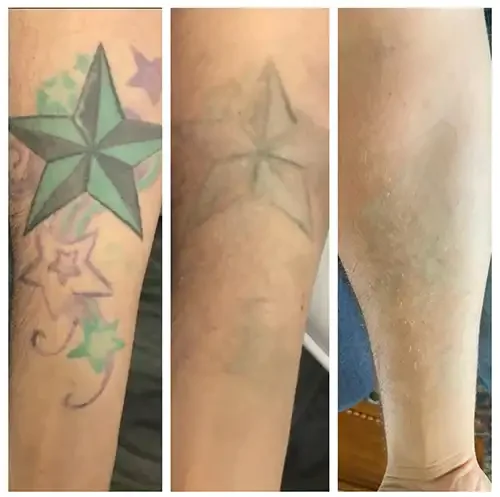Ruby Laser Tattoo Removal in Nairobi, Kenya
The Ruby laser is a type of solid-state laser that uses a synthetic ruby crystal as its gain medium. The term “ruby laser” is derived from the use of a ruby crystal, which is chromium-doped (contains small amounts of chromium ions).
Ruby lasers were historically used for tattoo removal, but their popularity has diminished over time in favor of other laser technologies that are more effective and less likely to cause side effects. The primary reason for this shift is that ruby lasers emit red light at a wavelength of 694.3 nanometers, which is strongly absorbed by dark pigments such as those found in tattoos.

Ruby Laser Tattoo Removal
A brief overview of how a Ruby laser works:
- Gain Medium: The ruby crystal is the gain medium, where the amplification of light occurs. The chromium ions in the crystal play a crucial role in the laser’s operation.
- Pumping: The ruby laser is pumped with intense light, typically from a flashlamp. This pumping process excites the chromium ions within the ruby crystal to a higher energy state.
- Spontaneous Emission: As the chromium ions return to their lower energy state, they emit photons spontaneously. This is the natural process that occurs in the gain medium.
- Stimulated Emission: Photons emitted spontaneously stimulate other excited chromium ions to emit coherent light in phase with the stimulating photons. This leads to the amplification of light through stimulated emission.
- Output: The coherent light produced by the stimulated emission exits the laser cavity through one of the mirrors, creating the laser beam.
Today, Q-switched lasers, such as those using Nd: YAG or alexandrite as the gain medium, are more commonly used for tattoo removal. These lasers offer a range of wavelengths, making them more versatile for targeting different tattoo colors while minimizing the risk of scarring and other side effects. If you are considering tattoo removal, it’s advisable to consult with a qualified dermatologist or laser specialist who can assess your specific case and recommend the most appropriate laser treatment based on your skin type and tattoo characteristics.
Ruby Laser Tattoo Removal Process
The process of Ruby laser tattoo removal involves several steps. Here’s an overview of how the procedure typically works:
- Consultation: Before undergoing laser tattoo removal, at Rebel Inks Tattoos, Tattoo Removal, and Body Piercings Parlour we often advise our clients to have a consultation with one of our qualified laser specialists. During this consultation, our practitioner assesses the tattoo, discusses expectations, and evaluates factors such as skin type and the colors of the tattoo pigments.
- Preparation: The area to be treated is cleaned, and a topical numbing cream may be applied to minimize discomfort during the procedure.
- Eye Protection: At Rebel Inks Tattoos, Tattoo Removal, and Body Piercings Parlour, both the client and our practitioner wear protective eyewear to shield their eyes from the laser light.
- Laser Settings Adjustment: The Ruby laser is set to specific parameters based on the tattoo’s characteristics, including its size, colors, and location. The wavelength of the Ruby laser (694.3 nanometers) is particularly effective for targeting dark pigments.
- Laser Pulses: The laser is then directed at the tattooed skin, emitting short pulses of high-intensity light. The laser energy is absorbed by the tattoo pigments, causing them to fragment into smaller particles.
- Body’s Natural Processes: Over time, the fragmented pigments are gradually eliminated from the body through natural processes. The immune system plays a role in clearing the broken-down pigments.
- Multiple Sessions: Tattoo removal is often a gradual process, and multiple sessions are usually required. The number of sessions depends on various factors, including the size, color, and age of the tattoo, as well as individual skin characteristics.
- Post-Treatment Care: After each session, our clients are typically provided with post-treatment care instructions. This may include keeping the treated area clean, avoiding sun exposure, and using recommended ointments or creams to promote healing.
- Follow-Up Sessions: At Rebel Inks Tattoos, Tattoo Removal, and Body Piercings Parlour we schedule follow-up sessions based on the progress of tattoo removal. The intervals between sessions allow the skin to heal and the body to naturally eliminate the fragmented pigments.
While Ruby lasers were historically used for tattoo removal, newer laser technologies, such as Q-switched lasers with different wavelengths, are now more commonly employed for their improved efficiency and safety profile. The choice of laser may vary depending on the specific characteristics of the tattoo and the individual’s skin type.
Ruby Laser Tattoo Removal Mechanism
The mechanism of Ruby laser tattoo removal involves the principles of selective photothermolysis, a process that targets specific chromophores (color-absorbing molecules) without damaging surrounding tissues. Here’s a step-by-step explanation of how the Ruby laser works for tattoo removal:
- Absorption of Laser Light: The Ruby laser emits light at a specific wavelength of 694.3 nanometers. This wavelength is highly absorbed by dark pigments, such as those found in tattoos. The energy from the laser is selectively absorbed by the tattoo pigments.
- Photothermolysis: As the laser light is absorbed by the pigments, it causes them to heat up rapidly. This process is known as photothermolysis, where the targeted pigments absorb the laser energy and convert it into heat.
- Fragmentation of Pigments: The rapid heating of the tattoo pigments leads to a thermal shock, causing them to break down into smaller particles. The goal is to shatter the ink particles into fragments that are small enough for the body’s immune system to naturally clear away.
- Macrophage Action: The body’s immune system recognizes the fragmented tattoo pigments as foreign particles. Macrophages, a type of white blood cell, engulf these particles and transport them to the lymphatic system for elimination.
- Gradual Clearance: Over time, the broken-down pigment particles are gradually cleared from the body through natural processes. This results in a fading of the tattoo over multiple treatment sessions.
- Selective Targeting: The Ruby laser is effective for targeting darker pigments, such as black and dark blue inks. It may be less effective for lighter colors. Other lasers with different wavelengths may be used in conjunction with or instead of Ruby lasers for tattoos with a variety of colors.
The success of tattoo removal depends on various factors, including the type and color of the tattoo, the individual’s skin type, and the expertise of the practitioner. Multiple sessions are typically required for optimal results, and there may be some temporary side effects, such as redness and swelling, following each treatment session. Advances in laser technology have led to the development of Q-switched lasers, which are often preferred for tattoo removal due to their versatility in targeting a broader range of ink colors and reduced risk of side effects.
Ruby Laser Tattoo Removal Aftercare
After undergoing Ruby laser tattoo removal, proper aftercare is essential to promote healing, minimize potential side effects, and optimize the results of the procedure. Here are general guidelines for Ruby laser tattoo removal aftercare:
- Keep the Area Clean: Gently clean the treated area with mild soap and water. Avoid scrubbing or rubbing the area to prevent irritation.
- Apply Topical Ointments or Creams: Follow any specific instructions provided by your practitioner. They may recommend applying an antibiotic ointment or a soothing cream to help with healing and reduce the risk of infection.
- Avoid Sun Exposure: Protect the treated area from direct sunlight and UV exposure. Use sunscreen with a high SPF to prevent sun damage to the healing skin. Sun exposure can increase the risk of pigmentation changes and other complications.
- Avoid Scratching or Picking: Refrain from scratching or picking at the treated area, as this can disrupt the healing process and potentially lead to scarring.
- Cool Compresses: If there is any swelling or discomfort, you can apply cool compresses to the treated area. This can help reduce inflammation and provide relief.
- Hydrate the Skin: Keep the skin well-hydrated by using a gentle, fragrance-free moisturizer. Hydrated skin promotes healing and can alleviate dryness or itching.
- Avoid Strenuous Activities: Avoid engaging in strenuous activities that may cause excessive sweating or friction on the treated area. This can help prevent irritation and ensure proper healing.
- Follow Post-Treatment Guidelines: Adhere to any specific post-treatment guidelines provided by your practitioner. This may include avoiding certain skincare products, activities, or medications during the healing process.
- Attend Follow-Up Appointments: Attend scheduled follow-up appointments with your practitioner. They can assess the progress of the tattoo removal, address any concerns, and make adjustments to the treatment plan if necessary.
Stay Hydrated and - Maintain a Healthy Diet: Drink plenty of water to stay hydrated, which can contribute to overall skin health. Consuming a balanced diet rich in vitamins and nutrients can also support the healing process.
Individual responses to laser tattoo removal can vary, and the aftercare recommendations may be customized based on your specific case. If you experience persistent or concerning side effects, it’s important to contact your practitioner for guidance. Following the aftercare instructions diligently can help minimize complications and contribute to successful tattoo removal.
Advantages of Ruby Laser Tattoo Removal
While Ruby lasers have been largely replaced by newer laser technologies for tattoo removal, they do offer certain advantages in specific cases. Here are some potential advantages of Ruby laser tattoo removal:
- Effective for Dark Pigments: Ruby lasers are particularly effective at targeting dark pigments, such as black and dark blue inks. The wavelength of the Ruby laser (694.3 nanometers) is well-absorbed by these pigments, facilitating their breakdown.
- Selective Targeting: The selective photothermolysis principle allows Ruby lasers to selectively target the specific chromophores in tattoo pigments without causing significant damage to surrounding tissues. This can be advantageous for minimizing side effects.
- Historical Significance: The Ruby laser was the first successful laser developed for any application, including tattoo removal. While newer lasers have surpassed it in terms of efficiency and versatility, the Ruby laser holds historical significance in the development of laser technology.
Despite these advantages, it’s important to note that Ruby lasers also come with limitations and potential drawbacks, including:
- Limited Wavelength: The Ruby laser has a limited wavelength, making it less versatile for treating a broad range of tattoo colors. It may not be as effective for lighter-colored inks.
- Risk of Side Effects: Ruby laser tattoo removal has been associated with a higher risk of side effects, including scarring and changes in skin texture. The laser energy can affect surrounding tissues, leading to complications.
- Less Efficient: Ruby lasers are generally less efficient compared to newer laser technologies, requiring multiple sessions to achieve satisfactory results. More advanced lasers, such as Q-switched lasers, are now preferred for their improved efficiency.
- Not Ideal for All Skin Types: The effectiveness of Ruby lasers can vary based on an individual’s skin type. It may not be the most suitable option for everyone, and other lasers may be better suited for different skin tones.
While Ruby lasers may still be used in specific cases, the field of laser tattoo removal has seen advancements with the introduction of more versatile and efficient lasers. Q-switched lasers, such as those using Nd: YAG or Alexandrite as the gain medium, are now commonly preferred for their ability to target a variety of tattoo colors with reduced risk of side effects. If you are considering tattoo removal, it’s advisable to consult with a qualified practitioner who can assess your specific case and recommend the most appropriate laser technology based on your tattoo characteristics and skin type.
Get In Touch
For more information on the list above and any other special services,please call or come in for free consultation
Testimonials
After he pierced my industrial piercing and seeing his amazing work, I feel even more excited about getting my tattoo with him in January. I’m really looking forward to it!
I am extremely happy with my new 'Safari' tattoo from Eric at Rebel Inks! The quality of the artwork is fantastic. Eric is a true professional and an amazing artist.
The preparation and design process was thorough and collaborative. He was very patient with my specific requests, including making sure all the elements, which hold personal meaning, were perfect.
The service was friendly and highly professional from start to finish. Despite the 8-hour session, Eric was a pleasant person to spend the time with.
The aftercare guidance and follow-up have been excellent and careful, which has made the healing process easy and better than expected.
I highly recommend Eric for anyone looking for a thoughtful, talented, and caring tattoo artist.
I recommend them 💯
I would definitely recommend if you’re thinking of getting a piercing!
The staff were super friendly, explained everything clearly, and made me feel so at ease. They answered all my nervous questions (and I had many questions),
They walked me through the whole process, gave detailed aftercare instructions, and even followed up afterward to check how I was healing 🫶
Clean, professional, and full of good vibes.
Would 100% recommend . Definitely making a second trip here.
This was the second tattoo I got and I wish I could have come to Eric for my first one! He gave me really great after-care directions for the tattoo as well as a little jar of his own Vaseline-type stuff to put over my tattoo while it was healing! He even put second skin over my tattoo so that I didn’t have to worry about it for the first few days. Now THAT’S good service. My first tattoo artist didn’t do none of that lol.
After the session Eric didn’t rush me and my friend out, he chatted with us and even when he found out I was an artist too— really encouraged me to keep creating and to find a community of artists to support me. I almost cried because I’ve had such a hard time with my own art the past couple of years, it meant so much to me to have a fellow very talented artist say that to me. 🤍🤍🤍
Eric you’re amazing, don’t ever stop creating and just know you’ve impacted lives all over the world!🫶🏻 thanks so much for everything!!
From the moment I walked in, Eric was professional, welcoming, and attentive. He made sure I was comfortable throughout, provided everything I needed, and explained every step of the process. The tattooing itself was unbelievably smooth - I genuinely felt no pain compared to my previous tattoos over the last 22 years.
Eric also gave me excellent aftercare guidance and products, and thanks to that, my tattoo healed beautifully. The attention to detail, precision, and shading are absolutely stunning. This is hands-down the best tattoo I've ever had, and I will be flying back to Nairobi for any future ink.
If you want incredible art, a professional experience, and a talented artist who truly cares about his clients, Rebel Ink is the place to go!
From start to finish, the service was exceptional. The piercer was professional, knowledgeable, and made me feel completely comfortable. The cleanliness of the place was above and beyond — everything was spotless and hygienic, which really put me at ease. Highly recommend for anyone considering a piercing!
Shout out to Eric😘
We ended up changing the jewelry three times to ensure I had the best fit and avoided any signs of rejection, and he always listened to my suggestions as a client, which I really appreciated. Now, three months in, my piercing is healing beautifully, with no sign of rejection. Highly recommend for anyone who values a piercer who cares about your comfort and healing journey!
What stood out the most was the aftercare Eric checked in with me even three weeks later to see how the tattoo was healing. That kind of follow-up shows how much he truly cares about his work and his clients.
I’m very satisfied and will definitely be coming back for my next piece. Highly recommend!
The piercing wasn't as painful as I had thought and the process was quick and satisfactory. I love it!!!
The piercing is healing well thanks to the aftercare instructions and follow-up. I would highly recommend Rebel Inks
Eric also did a belly button piercing for a friend, guiding her through the process, doing the piercing and then explaining the after care to her.
The shop is on the 3rd floor, with the entrance to the stairs near an alleyway on the left. The shop is perfect size, clean, and attractive looking. The mural is pretty dope.
Thank you for the amazing service! 🔥👅✨
I got piercibgs there and the process was really good. My biggest concern was hygiene but that wasn't an issue at all, they use new needles and they sanitize them.
The service itself was also welcoming.
I was informes of everything i needed to know beforehand.
10/10 would recommend!
Eric was so calm and patient with my almost 2 year old lady. It was such a clean and hygienic process. We will definitely be back for our second rounds of piercings and maybe even another tattoo!
They assess the area before any art and advise one accordingly. They also give one post clean up process and also do a check up after the body art projects. Overall, I loved my experience and I’m hooked. 👍
Will definitely come back next time I’m in town 🙂
He listened to what I actually wanted and made sure he could fit in the time before I flew back home.
The shop is clean & private and is easy enough to find.
Eric has even checked in a couple of times since to make sure all is good.
I would totally recommend Eric! I absolutely love my Elephants!
I had a very easy healing period and always follow up from Eric to check on my progress...I would highly recommend if you are a first timer because from my experience all went very well and attention to detail
Thank you for a good job and looking forward to send all my friends your way
And all the best with the new year 2025!
From the moment I walked in, the staff was super friendly and made me feel at ease. The studio had a clean, professional atmosphere, which immediately put me at ease. My piercer was incredibly skilled and explained every step of the process, ensuring I was comfortable the entire time. The piercing was quick and practically painless, and the aftercare instructions were clear and easy to follow. I can tell they really care about the health and safety of their clients.
Overall, a fantastic experience—I highly recommend Rebel Inks and Tattoos for anyone looking to get pierced or tattooed!
They do follow up after their services
Eric's Studio isn’t just a place to get a tattoo—it’s an experience. The combination of professionalism, artistic talent, and a welcoming environment makes it a standout destination for anyone considering a tattoo.
I highly recommend Eric’s Studio to both first-timers and seasoned tattoo enthusiasts. If you’re looking for a high-quality tattoo and an enjoyable experience, this is the place to go.
I would definitely recommend their services again and again
Thank you Rebel Ink
My piercings are healing ❤️🩹 well
I would 💯 recommend
I will definitely come back for more .
Two, all the equipments he used for the piercings were new and/or sterilised.
Three, the parlour itself was very clean and was up to par with the hygiene standards.
Four, Eric provided effective aftercare instructions, making sure I knew exactly how to take care of my new piercings and he kept in touch and continues to do so, to check on the healing progress.
I highly highly highly recommend this place!!!
Would definitely recommend them to friends and go back for other piercings
Not only was the piercing process smooth, but he also provided thorough aftercare instructions, making sure I knew exactly how to take care of my new piercings. What really impressed me was that he keeps in touch to check on how the healing is progressing – a sign of true care for his clients.
The shop maintains a high standard of hygiene, and the atmosphere is welcoming and comfortable, which really added to the positive experience. I highly recommend this place to anyone looking for a professional and caring experience. I’ll definitely be coming back for any future piercings!
My appreciation for the excellent customer service I received. The follow-ups were prompt, and I truly appreciated the gentleness and professionalism throughout. Thank you!"
"Looking for professional eyebrow microshading removal? Look no further!"
The customer care is top tier 👌🏾👌🏾.
Wonderful place to get tattoos and piercings. 💯💯
Eric goes ahead to follow up on his clients progress and gives good advice each time I reach out to him.
I would recommend Reble tattoos anytime.
Good job bro we really appreciate.
Ohh and the price is very fair.
The environment was clean , procedure was sterile and the jewelry used are of the best quality.
He followed up with me during the healing process, he educated me on what I needed to do for my aftercare.
Eric is confident, skilled , experienced and the best piercer. Highly recommend Rebel inks.✨
Definitely recommend!
Great experience.
Eric definitely know what he is doing .
I got exactly what I wanted 2 tiny tats on the same finger .
He was kind and patient throughout the session.
Healing process has been good .
Aftercare services were given and regular checkups on the healing process were done.
I would 💯recommend.
Eric gave me the best reception as it was my first time there,and made me trust him all the way. I appreciate good services.
There services are also affordable not to forget 😊.
He was also invested in the aftercare and would ensure I follow the do's and don'ts in taking care of the tattoo and ensuring proper healing and maximum ink retention.
Would highly recommend Rebel Inks Tattoos.
Rebel Inks Tattoo offer the best,affordable and quality tattoo removal services.If you have unwanted ink,choose Rebel Inks Tattoo,they're the best of the best and the professionalism is a top notch.They ensure you're free from unwanted ink with their Laser Tattoo Removal Technology...
I did a Laser Tattoo Removal with them and i can attest they're the best....
Kudos Eric...
I highly recommend.
It was a generally good experience with good hygiene during the piercing process and has been a smooth healing process.... 10/10
tips. Highly recommend 👍🏽
100% recommendable.
I was particularly impressed with Eric's attention to hygiene. He thoroughly cleaned the room before I entered, sanitized all of the equipment he would be using, and changed gloves between each ear. This level of cleanliness gave me great confidence in his professionalism.
Eric's commitment to customer service did not end on the day of the piercing. He followed up with me regularly throughout the healing process to ensure that I was following the aftercare instructions and that my earlobes were healing properly.
I highly recommend Rebel Inks to anyone in Nairobi who is considering getting a piercing. Eric is a highly skilled and experienced piercer who takes great pride in his work.
So I Check all the boxes below and more:
Customer Care: ✔️
Professionalism : ✔️
Cleanliness ✔️
Price: ✔️
After care service ✔️
Thanks and good job, Eric
The place is neat and clean and the equipments he used were also fine standards. Really appreciate his following up with me on the healing 🤗
I WOULD HIGHLY RECOMMEND THEIR SERVICES to everyone. Actually what you see on their website is EXACTLY what you will get. Keep up the good work Rebel inks Tattoos.
The infection is now gone. I would definitely recommend!
Can recommend this place totally and would go back there anytime!
Thanks!
OUR LOCATION
Areas We Serve
NAIROBI
KIAMBU
KAJIADO
MACHAKOS










































































































































































































































